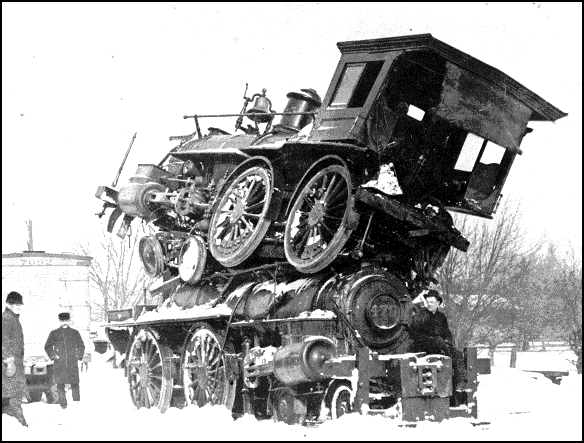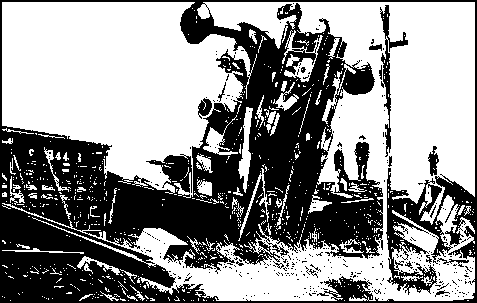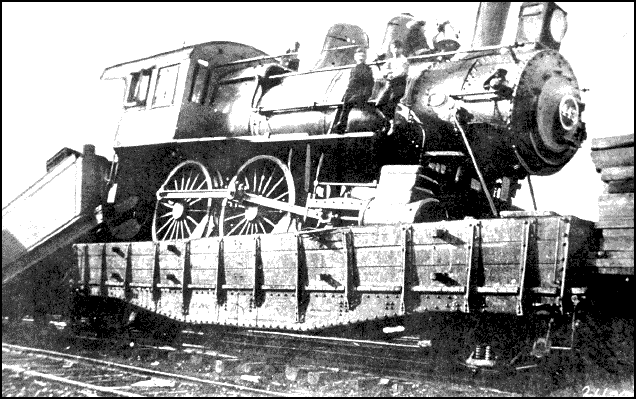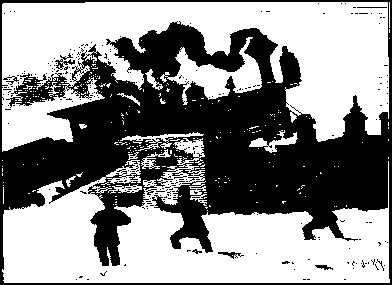
Train Wrecks:
A Pictorial History of Accidents
On the Main Line
Robert C. Reed
(Schiffer)

When I was a kid growing up in north Florida, train wrecks were not allowed. The Atlantic Coast Line Railroad owned the local rag, the Florida Times Union, so any crossing accidents --- at least on the Coast Line --- were ignored or banished to 3-point type on the back pages, under the pork-belly futures market. We had to find out about them by word-or-mouth, or by dying in one.What is it about train wrecks that delights us old rail buffs? Certainly those into old cars don't want to see a Duesenberg tangled up with a Model T. Sports car racing enthusiasts don't go gaga over stock cars in a heap. Airplane nuts don't look for pictures of 707s falling from the sky. Sailboat aficionados don't want to see a three-masted schooner keel up. Dune buggy enthusiasts don't seek out four fat wheels sticking up in the air, revolving ever so slowly.Maybe it is the sheer massiveness of it: a 150 ton Baldwin 2-6-2 tipped over, a Pennsylvania Railroad engine upside-down in the Delaware River, an old Soo Line steam engine bent double, amidst tracks bent double as well.Whatever it is, we rail fans will seek out pictures of the most awful tumbles, tracks torn up, boilers exploded, telescopic wrecks where the engine of a train from behind fits uncomfortably inside a rail passenger car (imagine those people glancing back and seeing a black steaming locomotive coming straight at them, 75 mph. Wouldn't that be a heart-stopper?)

Mr. Reed has put together a hundred or so lithographs and photographs from the last two centuries showing engines, passenger cars, and passengers in a variety of awkward positions. He takes us back to some of the very earliest wrecks, such as the Camden & Amboy near Burlington, New Jersey, where two engines mounted up, as witnesses reported, "like two dogs in a fight." He tells of the first railroad death, one in 1831 that occurred on the South Carolina Road when an engine blew up and killed a black slave trainman.Early engines had no brakes --- they had to be stopped by the conductor hitting the brakes in the passenger cars. Since the first trains ran slowly and scarcely ever at night (roaming livestock was dangerous; early engines didn't carry a cow-catcher) it wasn't until the year 1853 that wrecks began to happen on a massive scale. This was due to increased weight, speed, train lengths, and traffic.
By the end of the 19th century, the number of wrecks and deaths skyrocketed: 8,216 collisions and derailments were recorded in 1880 alone. Part of the blame lay with the federal government's policy of giving land away to those railroads who laid their tracks quickly. It was often done in such a shoddy fashion that tracks came apart, street crossings showed no warnings, and railroad bridges were not up to the task.

Early coaches were of wood, and in winter, were heated by coal stoves. Any accident could set the passenger car on fire. Imagine racing to Moline one night at 50 mph or so, there's a lurch, the stove tips over, and you have the choice of getting fried or jumping out the window into the dark.The book is divided into thirteen parts, including "Boiler Explosions," "Crossing Accidents," "Runaways," "Hotboxes and Broken Parts," "Bridge Disasters," and "Head-On Collisions." It gives us shots of over a hundred selected wrecks, including whole trains wandering off the tracks and down hills, toppled over the sides of bridges, exploded, eviscerated, and one delightful bang-up on New York's old Third Avenue El.
These lithographs and photographs are intermixed with ads for passenger cars, safety switches, passenger-car heaters, and bridge-building companies.
Our favorite wrecks (some shown here) reveal engines crawling atop of each other, like a dog and a bitch in heat. Those who didn't care to be in a wreck could watch from a distance: early State Fairs would feature head-on collisions between retired steam engines. Who could resist a noisy spectacle like that?
If you think that we're out of the woods, The New York Times Almanac tells us that during the years 2000-2001 there were almost 5,000 accidents in the U.S. The rail company with the best safety record per million miles was Norfolk Southern. The worst (with an accident rate almost double the nearest competitor) was the Kansas City Southern.

--- Robin A. Woodstock